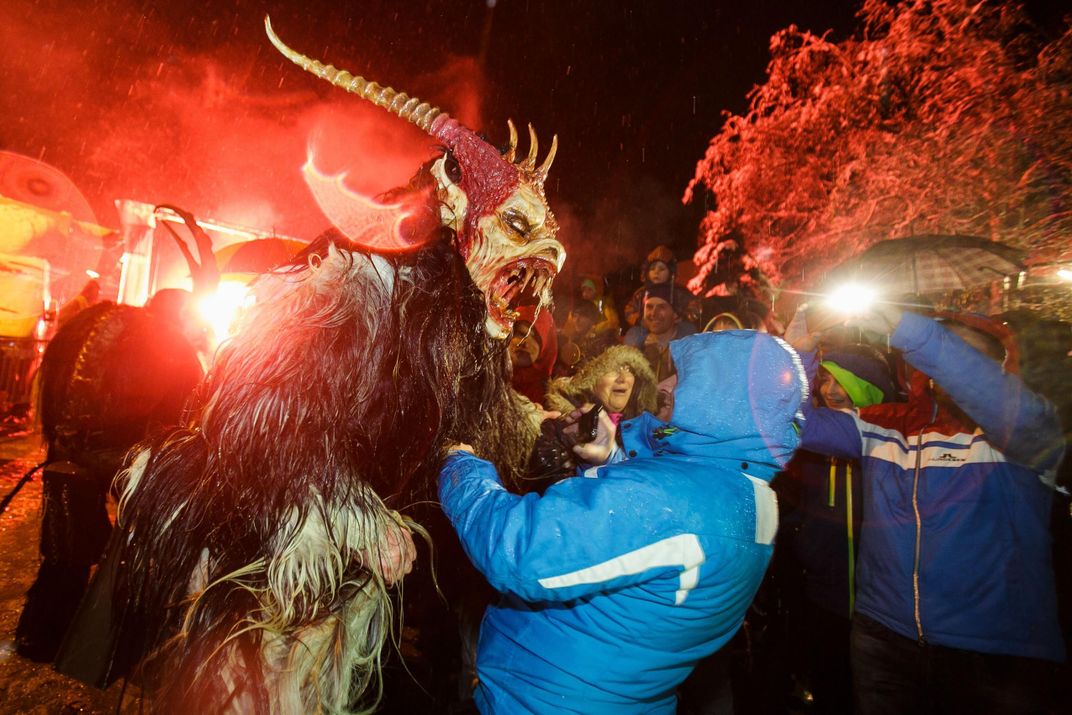The Origin of Krampus, Europe’s Evil Twist on Santa
The mythical holiday beast is once again on the prowl, but beware, he’s making his way across the Atlantic
:focal(994x662:995x663)/https://tf-cmsv2-smithsonianmag-media.s3.amazonaws.com/filer/ef/09/ef094ed8-3dfe-45f3-a52a-721dde457d93/42-79160112.jpg)
A mangled, deranged face with bloodshot eyes tops a furry black body. Giant horns curl up from his head, displaying his half-goat, half-demon lineage. Behind this terror, a dozen more stomp through the snow of the streets of Lienz, Austria, among a din of cowbell jangles. The creatures dash through the streets, chasing giggling children and adults alike, poking them with sticks and scaring some with the realization that they were naughty this year.
Lienz' annual Krampus Parade, also known as Perchtenlauf or Klaubaufe, resurrects a centuries-old tradition: Young men in town dress up as the mythical creature and parade through the streets in an ancient pagan ritual meant to disperse winter's ghosts. They march dressed in fur suits and carved wooden masks and carrying cowbells. The tradition—also known as the Krampuslauf, or Krampus Run—is having a resurgence throughout Austria, Germany, Slovenia, Hungary and the Czech Republic, and has gained recognition in the United States.
The creature has become so popular in recent times that he has a comic book series, parties of his own and even a new movie. After all, says Jeremy Seghers, organizer of a Krampusnacht festival being held for the first time in Orlando, Florida, why watch out when Santa Claus comes to town? "Because Krampus is coming to get you."

Krampus himself historically comes around the night of December 5, tagging along with St. Nicholas. He visits houses all night with his saintly pal. While St. Nick is on hand to put candy in the shoes of good kids and birch twigs in the shoes of the bad, Krampus' particular specialty is punishing naughty children. Legend has it that throughout the Christmas season, misbehaved kids are beaten with birch branches or can disappear, stuffed into Krampus' sack and hauled off to his lair to be tortured or eaten.
"The Krampus is the yin to St. Nick's yang," Seghers tells Smithsonian.com. "You have the saint, you have the devil. It taps into a subconscious macabre desire that a lot of people have that is the opposite of the saccharine Christmas a lot of us grew up with."
In fact, Krampus' roots have nothing to do with Christmas. Instead, they date back to pre-Germanic paganism in the region. His name originates with the German krampen, which means "claw," and tradition has it that he is the son of the Norse god of the underworld, Hel. During the 12th century, the Catholic Church attempted to banish Krampus celebrations because of his resemblance to the devil. More eradication attempts followed in 1934 at the hands of Austria's conservative Christian Social Party. But none of it held, and Krampus emerged as a much-feared and beloved holiday force.
For some, the annual festival of child-hunting Krampus is fun—but concerns that refugees in the Alpine towns that celebrate Krampus could find the tradition frightful has prompted some towns to consider taming the horror. This year, Krampus' scheduled arrival in the Alpine towns that celebrate him coincides with an influx of refugees from Syria and Afghanistan. Though the festival is well-loved, it gave rise to concerns that the new neighbors might be scared of the tradition and its nightmare-fueling costumes. Rather than cancelling the parade, town officials decided to educate the newcomers. The Telegraph's Rozina Sabur writes that refugee children in Lienz were invited to a presentation where they learned about the props, costumes and customs of Krampus.
Seghers likes the idea of introducing Krampus to refugees in Austria. "I think it's wonderful that they want to get the refugees used to this sort of thing," he says. "You can’t force people to adopt cultural traditions of which they have no basis or point of reference."
Perhaps you'll be the next to catch the Krampus spirit this holiday. After all, the horrible haunt could very well be watching you.
Planning Your Next Trip?
Explore great travel deals
Smithsonian magazine participates in affiliate link advertising programs. If you purchase an item through these links, we receive a commission.
/https://tf-cmsv2-smithsonianmag-media.s3.amazonaws.com/accounts/headshot/JenniferBillock.png)


/https://tf-cmsv2-smithsonianmag-media.s3.amazonaws.com/accounts/headshot/JenniferBillock.png)